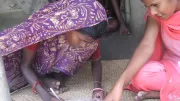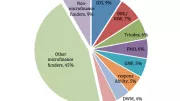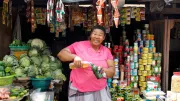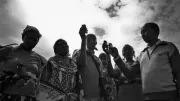Recent Blogs
Blog
Who Should Pay for Banking Infrastructure in G2P Programs?
In 2006, 300 of Colombia's 1,100 municipalities had no access to banks. Now, 99% do. Incentives, while not enough to stimulate investment by private financial institutions in all remote areas, played a significant role in helping to build agent networks througout the country.Blog
New Directions for Funders: Insights and Perspectives
How can funders balance the need for flexibility and accountability requirements with partners while ensuring effective outcomes? The answer lies in defining a monitoring and impact evaluation system that includes a "theory of change," quick feedback loops and reasonable assumptions.Blog
Freemium: Spawning An Insurance Market In Ghana
The experience of Tigo Family Care Insurance in Ghana makes the case for freemium services. In underdeveloped markets, offering initial services for free can encourage uptake of paid services in the long run.Blog
Can Phones Drive Insurance Markets? Initial Results From Ghana
Burials in Ghana often put a strain on household budgets of the poor. The insurance market offers very few products, especially to poor customers.Tigo's new mobile insurance product called "Freemium" hopes to change that.Blog
Impact Research and the Role of Coaching In Poverty Reduction
Effective coaching–designed to impart basic financial education and livelihood skills– is a critical ingredient of programs aiming to graduate households out of extreme poverty. How can we more effectively train coaches to address differentiated needs? Impact research plays a crucial role in filling this knowledge gap.Blog
Market Building Through Financial Sector Deepening In Africa
How do we support a market building approach in practice? The current advice is to either become a market facilitator or fund one. But what is a market facilitator; what do they do?Blog
Product Development Doesn’t End with Design
Product development does not and should end with a designed product. The role of creative thinking to circumvent challenges and identify the right opportunities cannot be underestimated if a product is to be successfully designed, launched and most importantly, used by those for which it was intended.Blog
Financial Inclusion in Latin America: Looking Back, then Forward
In Latin America, 2012 has seen continued and increased efforts on financial inclusion across the region by providers and policymakers, although it wasn't a year without challenges.Blog
Savings: Global Learning For Local Application
What can a study about 1,118 Nepalese women living in slums tell us about rural community savings programs in Colombia? This post explores the relevance of cross-border learning for financial inclusion.Blog
The Art of Discovery: Incubating Mobile Money Ideas In Uganda
How can we creatively design products that can have a real impact on the mobile money market? This post shares the experience of Grameen App Lab in Uganda.Blog
Can Self-Regulation Protect Microfinance Clients?
Effective self-regulation rests on two key components: a transparent and consistent standard to measure compliance and a credible mechanism to ensure that it can be enforced. Smart Certification provides that standard. What could provide its enforcement?Blog
Back To The Future Of Performance Reporting On Financial Services
There are at least four lessons that branchless banking stakeholders can take from the MFI experience when it comes to reporting standards.Blog
Nigeria Targets Real Financial Inclusion
In 2012, the Nigerian government set formal targets for financial inclusion and aims to bring down financial exclusion to 20% by 2020.Blog
Supporting Client Protection In Cambodia
Last week the Smart Campaign launched the much-anticipated Client Protection Certification Program, an independent, third party evaluation to publicly recognize financial institutions that meet adequate standards of care in how they treat clients. This post launches a short series that offers different perspectives on how certification can benefit clients, individual MFIs, and the broader sector. This post shares how AFD and FMO, the Dutch Development Finance Institution, are supporting client protection improvements in Cambodia.Blog
Pakistan: G2P Laboratory
Pakistan is becoming a laboratory for G2P payment innovations. A new report by CGAP discusses the G2P payments sector in Pakistan and demonstrates how social transfers can help bring poor people into the formal financial system.Blog
Financial Inclusion Highlights From China And Myanmar
In my (Chinese) New Year blog post of 2012, I predicted significant changes during the year of the dragon. I was not disappointed for sure. From a personal perspective I moved back to East Asia after several years of absence, and it was hard to recognize the region given the pace of development. In the last ten years poverty in East Asia has fallen from close to 50% down to 35% and economic growth has been relatively high compared with the rest of the world. Some of the most notable change has taken place in China, and in Myanmar more recently.Blog
Tech Start-ups and Financial Inclusion: Trends To Watch In 2013
In my last post, we talked about the potential for start-ups to shake things up in the financial inclusion space. But where’s the real opportunity today? At Venture Lab, we’ve got our eye on a number of trends for 2013.Blog
Jobs And Financial Inclusion
In the aftermath of the global financial crisis and with the mounting pressure of a demographic bulge of young people in many developing countries, the imperative of creating jobs has returned to the forefront of development priorities. At the same time, global leaders are concerned about inclusive growth and have made financial inclusion one of the pillars of the G20 development agenda. How are jobs and financial inclusion linked? The answer depends on what type of jobs we are talking about.Blog
Deepening Financial Inclusion In West Africa
A few weeks ago the Central Bank of the eight countries of the West Africa Economic and Monetary Union (WAEMU), BCEAO, shared the good news that in the last five years the banked population in the region increased by more than 5% from 9% in 2006 to 14.3% at the end of 2011. Postal banks and microfinance institutions that have a specific legal status in the region are now serving close to 9% of the population. The other 5% is served by commercial banks.Blog














